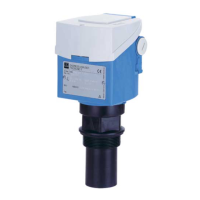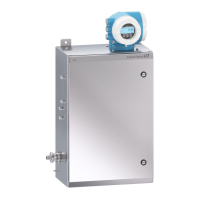Do you have a question about the Endress+Hauser TOCII CA72TOC and is the answer not in the manual?
Defines the intended application of the analyzer for monitoring TOC in wastewater.
Outlines safety precautions for installation, commissioning, and operation by trained personnel.
Emphasizes user responsibility for complying with safety conditions and regulations.
Instructions for returning the analyzer for repair, including cleaning and documentation.
Explains the meaning of warning, caution, note, and various electrical symbols used.
Details information found on the analyzer's nameplate, including manufacturer data and order code.
Explains the ordering code structure for the analyzer's configuration options.
Lists all items included in the analyzer's delivery package.
Mentions the product's compliance with European directives via EC directives.
Provides guidelines for inspecting and handling the analyzer upon receipt and during storage.
Describes methods of installation, compressed air/water supply, and environmental requirements.
Details mounting sequences, wall mounting, base frame mounting, media connections, and chemical preparation.
Lists checks to perform after installation to ensure proper connections and integrity.
General guidance on electrical connections, emphasizing safety and qualified personnel.
Safety warnings and checks before performing electrical connections.
Illustrates the power distribution wiring diagram.
Details how to connect signals, including analog and digital inputs/outputs and RS 232.
Describes the wiring arrangement for the power unit.
Shows the distributor assignment.
Lists the fuses used for different assemblies.
Checks to be performed after electrical connections are made.
Identifies and describes the main operating elements of the analyzer.
Explains the analyzer's display and keypad functions.
Covers recording mode and spot view for analyzing measurements.
Details the standby mode operation when sample flow is interrupted.
Essential checks to perform before starting the commissioning process.
Covers commissioning sequence and CLR start procedures.
Explains how to access and navigate the programming menu for configuration.
Configuration of measurement range parameters and related settings.
Procedure for setting the analyzer's date and time.
Configuration of high and low alarm limits for the analyzer.
Setting basic parameters like analog output, pump rates, and pH control.
Option to reset analyzer settings to factory defaults.
Naming the measuring point for identification.
Displays historical minimum, maximum, and average measured values.
Logs all maintenance procedures performed on the analyzer.
Records all alarm messages, including date, time, and event.
Provides a chronological display of all saved events.
Guides on testing analog and digital inputs of the analyzer.
Instructions for testing analog and digital outputs and pump functions.
Tests the function of the I/O card, including inputs and outputs.
Tests data transmission via the computer interface RS 232.
Deactivates measuring operation for testing without alarms.
Explains external control of sample selection for two-channel operation.
Details how to set up time-controlled switching between measurement channels.
Covers adjusting measuring range, pump influence, salt loads, and gas flow.
Details the analyzer's RS-232 serial interface parameters and data transmission format.
Instructions for cleaning the analyzer's exterior housing.
Guidelines for performing regular visual checks of the analyzer's components.
Procedures for refilling or replacing reagents and standard solutions.
Steps for replacing standard solutions and entering new concentrations.
How to input standard solution concentrations into the analyzer.
Overview of the maintenance tasks supported by the service software.
Covers replacing hoses on pumps P1, P2, P3 and adjusting pump P2, cleaning pump P5.
Covers adjusting and calibrating the analyzer, and empty volume dosing.
Details screen flushing, power flush, bypass screen, strip/separation chamber, circuit opening, combustion pipe, and leakage test.
Procedures for replacing acid, gas, O2, and heated salt trap filters.
Lists common error messages, their causes, and recommended remedial actions.
Lists spare parts and wear parts kits for the analyzer.
Instructions for returning the analyzer for repair, including decontamination.
Step-by-step guide to safely taking the analyzer out of service.
Guidance on the proper disposal of the electronic components.
Specifies the analyzer's input parameters and signal types.
Details the analyzer's output signals, data interface, and alarms.
Information on supply voltage, fuses, and connection standards.
Lists performance metrics like LOD, LOQ, drift, and repeatability.
Specifies environmental conditions for operation (temperature, humidity, IP rating).
Details process-related data like sample temperature, flow rate, and consistency.
Information on the analyzer's weight, materials, and construction.
| Device Type | TOC Analyzer |
|---|---|
| Enclosure Material | Stainless steel |
| Protection Class | IP54 |
| Ambient Temperature | 5 to 40 °C |
| Sample Pressure | 0.5 to 6 bar |
| Power Supply | 100 to 240 VAC, 50/60 Hz |
| Power Consumption | Approx. 150 VA |
| Communication Protocols | Modbus, Profibus, Ethernet/IP |
| Outputs | 4-20 mA, Relay |











